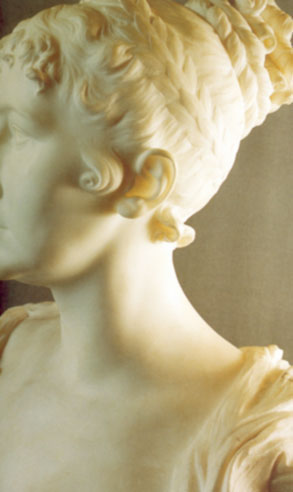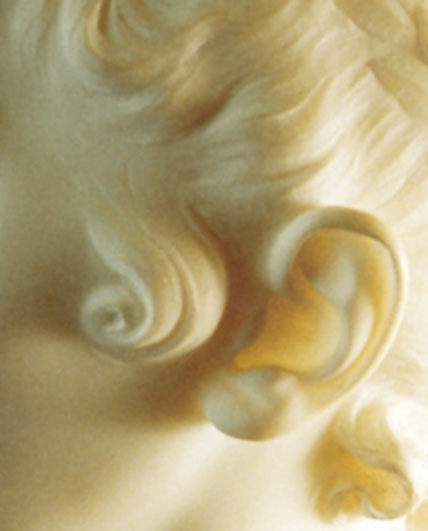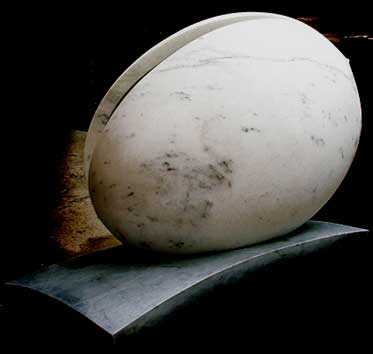


A Marble made Flesh,
makes me long to caress that marble.

There is an ancestral truth that is revealed
by the touch of the hands:
skin against skin,
flesh against flesh.
When my skin touches the marble,

Gianpietro Carlesso, Pro-memoria, 2003
Carrara marble, Bardiglio
my skin becomes marble,
a marble made flesh.
About the musical performance of
In nearly 30 years of performances with my cello, I've been faced too many times with the evidence that the modern “classical” concept of concerts is somehow wrong: music in the past – no matter how far away in time – has always been multi-medial, conceived in the multiple expressions of dance, poetry, visual effects, theatrical actions. Baroque Opera can be easily given as an example, but if you imagine a sacred ritual such as Easter in a medieval church, between the mighty columns and arches, the carved stones, the statues, the torches or the candle lights and the sounds of the choirs, it will be impossible to believe that such a musical experience can be matched just with the voices without a similar context, which is, in fact, a multi-medial experience. The meeting with an artist like Gianpietro Carlesso – whose works in wood or even in stone remind me very often of the idea of “musical instruments” – has been one of the most exciting for it relates to my desire to create a complex musical experience, blending the power of expression of other disciplines. Sculpture and musical performance may not seem to have much in common, at first sight, but if we consider that the arts are not only physical objects we can see and touch, we'll then inevitably come to the point of accepting as a “work of art” mainly the path that leads an artist to the production of the object. This is especially true in modern art, since we are free to believe in a total syncretism that allows all sort of hybrids. Thus a sculpture can be “conceptual”, and in the same way, a musical performance might be “sculptural”. Why? On the basis of these thoughts I created the music for one of the sculptures by Gianpietro Carlesso, and for the amazing beauty of the white marble that becomes his work “Pro-Memoria” , a giant seed open like a vulva, delicate and vibrating like a Faenza violin. I believe however that the viewing of the sculpture and the listening to the music must be separate, even if closely connected: during my performance, the sculpture will be near me only as the subject of my music, thus we'll have it only as a photographic image, somehow just like a memory of the concrete object, evocated by the light of some photos projected on me, in the dark, as the scene lights on my stage. Nevertheless, I want my music amplified near the sculpture, somewhere away from the room where I'll play, just in the same way as the sculpture's image will be on me: like a memory of my music. The “real things” are sculpted marble and direct sounds of an ancient cello, truly resonating between walls and the bodies of the public. The meaning and the reason of my music will be to perform an act of love for the beauty of the sculpted marble and for the concept vibrating into it. If you lean over Carlesso's sculpture called “Pro-Memoria” to look inside, you'll read the words “I have a dream” ; my music will humbly dream on the silky surface of that precious stone.
Claudio Ronco, Venice , March 2005.
Translated by Susan Wise.
«A sculpture exists in space much like a human being or a mountain, a tree or a cloud, and in order to fully appreciate it we must approach it
Claudio Ronco, cellist and composer.
Born in Torino, 1955, Claudio Ronco studied in the Conservatory under the guidance of Pietro Nava, former cellist of the Royal Opera Theatre. Interested in extra-european music, he graduated in 1976 from Calcutta University, India. In 1978 studied with Anner Bijlsma and Christophe Coin, in Genève, Basel and Paris. Since 1980 he has been the solo cellist of the celebrated Clemencic Consort of Vienna, with whom he has performed concerts and Operas all over the world, being active also in the greatest part of the huge discographical production of the group, mainly published by Harmonia Mundi, Sony, Accord Musifrance and the Italian label Nuova Era. He has realized several recordings of his own musicological discoveries, such as the works of the Neapolitan cello virtuoso Salvatore Lanzetti, as well as many first world recordings of great interest, such as the integral work for Duo of Nicolò Paganini, the complete piano Trios of the great Danish romantic composers N.W. Gade, or the splendid Sonatas for cello and piano by the celebrated romantic cello virtuoso Alfredo Piatti.
|
All the sculptures in these pages,
when not works of Giampietro Carlesso,
belong to the René Clemencic Sammlung of Vienna, photographed by:
Christine de Grancy

(By courtesy of René Clemencic)
©claudioronco2005
tutti i diritti riservati

Michael Blank (born 1959)
"Mounted Shadow" , Vienna 1996; rubber, lenght 165 cm.
"Ombra ascendente" , Vienna 1996;
foglio di gomma traforato e ritagliato, lunghezza 165 cm.

Marble bust of the fate Lachesis (detail),
Northern Italy, XVI cent., height 74 cm.
Busto marmoreo della Parca Lachesis (particolare)
Italia del nord, XVI sec, altezza 74 cm.

Bark globe "Water for the planet"
South Africa, outside Cape Town, 2001; wire frame wrapped in bark, diameter 30 cm.
Globo di corteccia, "Acqua per il Pianeta",
Sud Africa, fuori Cape Town, 2001; fil di ferro unito a corteccia, diametro 30cm.

Nakumbau initiation figure (detail).
Vanuatu (prev. New Hebrides), Malakula Island, N'botgote tribe
tree fern and bamboo covered with clay and lime; H. 198 cm, W. 50 cm.
Figura Nakumbau (particolare) per l'iniziazione e circoncisione dei maschi della tribù N'botgote,
Vanuatu (ex Nuove Ebridi), Malakula Island;
tronco d'albero e bamboo coperti di argilla e calce; altezza 198 cm, larghezza 50 cm.
![]()
Wooden slit-drums with ancestral head, from Vanuatu (formerly New Hebrides),
Ambrim, Fanla, height 360 cm.
Tamburo ligneo a fessura con testa di antenato,
proveniente da Vanuatu (ex Nuove Ebridi), Ambrim, Fanla; altezza 360 cm.

Wooden scupture of sitting Dignitary (detail)
China, early Qing period, end of XVII century, height 80 cm.
Scultura lignea di Dignitario seduto (particolare)
Cina, primo periodo Qing, fine XVII secolo, altezza 80 cm.

Brahamanda-Lingam stone, the Cosmic Egg;
Benares, height 83 cm.
Pietra Brahamanda-Lingam, l'Uovo Cosmico;
Benares, altezza 83 cm.

Victor Tilgner (1844 - 1896)
Marble bust of the Vienna Burg-Theater actress Charlotte Wolter (detail);
Carrara marble, height 82 cm.
Busto marmoreo dell'attrice del Burg-Theatre di Vienna Charlotte Wolter (particolare);
marmo di Carrara, altezza 82 cm.

Franz Xaver Seegen (1724 - 1780)
Academic figure of a male nude (detail)
Linden wood, height 163 cm.
Figura accademica di nudo maschile (particolare)
legno di tiglio, altezza 163 cm.

Violin of Faenza (maiolica) from the Museum of Rouen, France XVIII century.
Violino di Faenza del Museo di Rouen, Francia XVIII secolo.

Gianpietro Carlesso, Pro-memoria, 2003
marmo di Carrara, Bardiglio
cm. h. 100 x 110 x 130

Giampietro Carlesso, Mater-Bi, 1999
bronzo, cm. h. 320 x 100 x 60

Giampietro Carlesso, La memoria del bosco, 2004.
legno di rovere, cm. h. 110 x 340 x 110

Gianpietro Carlesso, Monumento clandestino, 2001.
pietra vulcanica, erba;
cm. h. 175 x 120 x 110

Gianpietro Carlesso, Vuoto di memoria, 2005
ferro brunito, prototipo in miniatura: cm h 36 x 71 x 45
Per l'esposizione di Lubiana sarà presentata una seconda versione dell'opera
delle dimensioni di cm. h. 160 x 500 x 350
For the Lubiana exibition will be made a second version of this work,
with the dimensions of 160 x 500 x 350 cm.
in darkened iron.

Gianpietro Carlesso, Biomoto, 2003
bronzo cm. h. 70 x 70 x 70
Per l'esposizione di Lubiana sarà presentata una seconda versione dell'opera
delle dimensioni di cm. h. 220 x 150 x 160, 2004, bronzo.
For the Lubiana exibition will be made a second version of this work,
bronze, with the dimensions of 220 x 150 x 160 cm.


